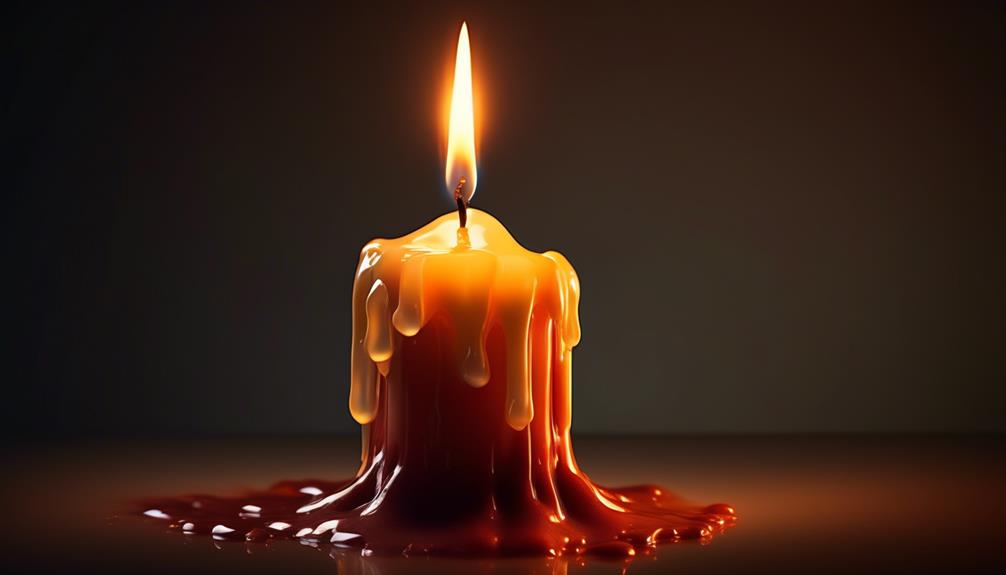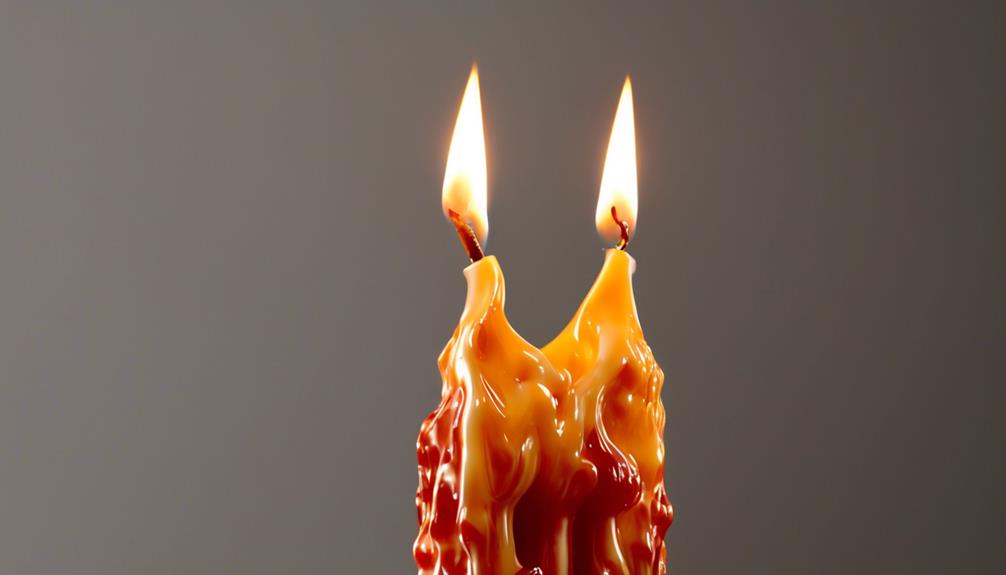Have you ever pondered what the maximum temperature a candle can attain is?
The temperature at which a candle flame burns is a fascinating topic that sheds light on various aspects of candle composition and behavior.
Understanding the factors influencing the heat of a candle can provide valuable insights into its safe usage and potential applications.
Let's explore the intriguing world of candle flames and discover the secrets behind their fiery glow.
Key Takeaways
- Candle flame temperature is influenced by factors such as fuel type, wick characteristics, and oxygen availability.
- The wax composition of a candle affects its burning time, appearance, and flame size.
- The choice of wick material impacts the burn quality and aesthetic of the candle.
- Flame height and candle size are indicators of fuel availability and temperature reached.
Factors Affecting Candle Flame Temperature
The temperature of a candle flame is influenced by various factors, including the type of fuel used, the wick's characteristics, oxygen availability, ambient temperature, and the presence of additives or fragrance oils.
The flame temperature of a candle is directly related to the type of wax used as fuel. Different waxes have varying combustion temperatures, affecting how hot the candle burns.
Additionally, the size, shape, and material of the wick play a crucial role in determining the temperature of the candle flame. A wick that's too large can lead to a higher flame temperature, while a wick that's too small may result in a cooler burn.
Oxygen availability is essential for combustion, impacting the temperature at which a candle burns. The ambient temperature surrounding the candle can also influence the flame temperature, with colder environments potentially causing the flame to burn hotter.
Furthermore, the inclusion of additives or fragrance oils in the candle can alter the flame temperature, making it essential to consider all these factors when determining the temperature of a candle flame.
Candle Wax Composition
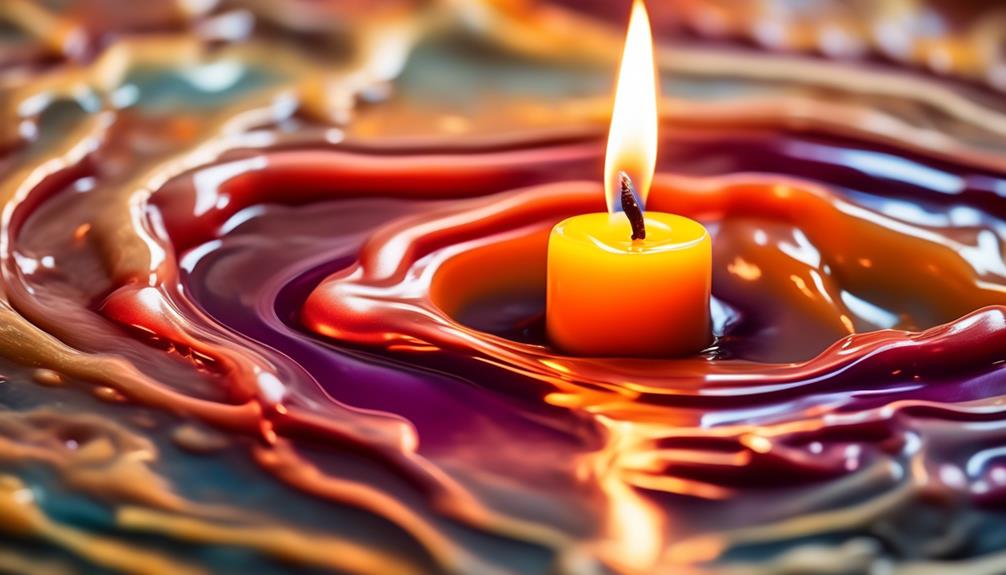
Comprising various types of wax, candle wax composition significantly influences the burning characteristics and performance of candles. The intricate blend of wax, additives, and fragrance oils in a candle impacts not only its appearance but also its functionality. Here's how candle wax composition can affect your candle experience:
- Melting Point Variation: Different waxes have varying melting points, influencing how evenly and efficiently the candle burns. This variation can determine the size and stability of the flame, affecting the ambiance created.
- Burning Time: The ratio of ingredients in the wax composition plays a crucial role in the burning time of a candle. This directly impacts how long you can enjoy the gentle flicker of the flame.
- Customization Potential: Candle makers can tailor wax compositions to achieve specific goals, such as cleaner burns or longer-lasting candles. This customization allows for a personalized touch in your candle selection, enhancing your overall sensory experience.
Wick Material Influence
Exploring the impact of different wick materials on candle burning characteristics reveals another crucial element in enhancing the overall candle experience. The wick material used in a candle can significantly influence how the flame burns, how evenly the wax melts, and ultimately, the overall performance of the candle. When selecting a wick material, factors such as the type of wax being used and the desired burn time of the candle must be considered to achieve optimal results.
To illustrate the significance of wick material influence, below is a table showcasing the characteristics of different wick materials commonly used in candles:
| Wick Material | Characteristics | Best For |
|---|---|---|
| Cotton | Clean burn, minimal soot | Most types of wax |
| Wood | Crackling sound, unique aesthetic | Soy and beeswax |
| Zinc | Self-trimming, consistent burn | Paraffin wax |
| Hemp | Slow burn, eco-friendly | Natural waxes |
Understanding the impact of wick material on candle performance allows for tailored candle creations that meet specific preferences and requirements.
Oxygen Availability Impact
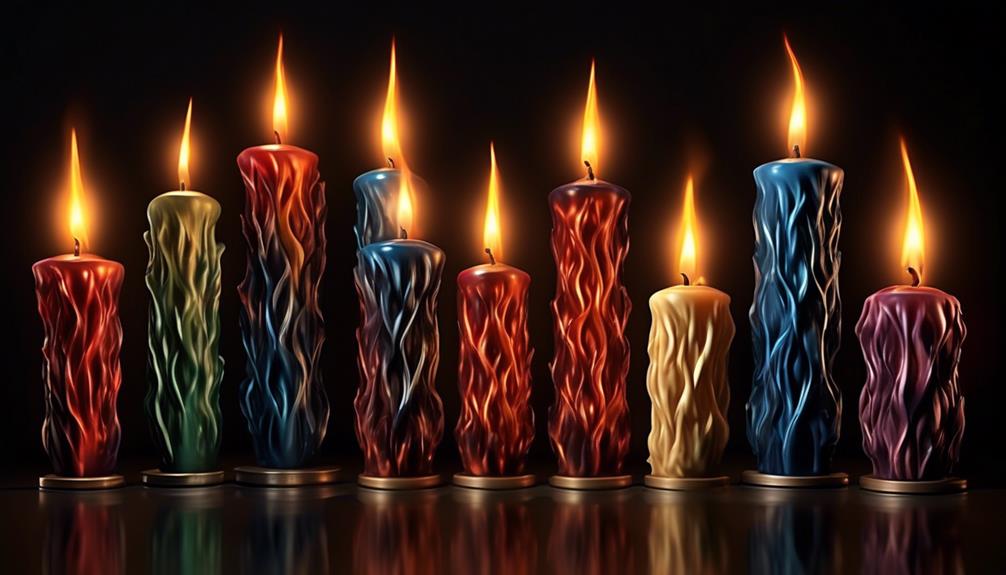
Considering the importance of oxygen in sustaining a candle's flame, understanding how oxygen availability impacts the burning process is essential for optimizing candle performance. When oxygen interacts with the burning candles, it plays a crucial role in maintaining the combustion reaction, influencing the temperature and characteristics of the flame.
Here's how oxygen availability impacts the burning process:
- Vibrancy of the Flame: Adequate oxygen supply results in a bright, steady flame that signifies efficient combustion, enhancing the ambiance created by the candle.
- Size and Shape: Insufficient oxygen can cause flickering or a smoky flame, affecting the overall appearance and performance of the burning candles.
- Temperature Regulation: Oxygen helps control the distribution of heat within the flame, ensuring proper burning at high temperatures while minimizing soot formation.
Flame Height Relationship
Studying the flame height of a candle involves examining the interplay between fuel availability and oxygen supply. The temperature of a candle flame is directly related to its height, with a taller flame indicating a higher temperature due to increased fuel consumption. Factors like wick size, material, and the presence of additives can also influence flame height. To illustrate further:
| Fuel Availability | Oxygen Supply | Flame Height | Temperature |
|---|---|---|---|
| High | High | Tall | High |
| Low | High | Short | Low |
| High | Low | Short | Low |
| Low | Low | Flickering | Low |
Maintaining a well-ventilated area with sufficient oxygen will result in a taller, more consistent flame. It is crucial to monitor the flame height to ensure it remains safe, preventing contact with flammable materials and keeping the candle away from drafts. By understanding the relationship between fuel availability, oxygen supply, flame height, and temperature, one can optimize the burning process for both efficiency and safety.
Candle Size and Heat Output
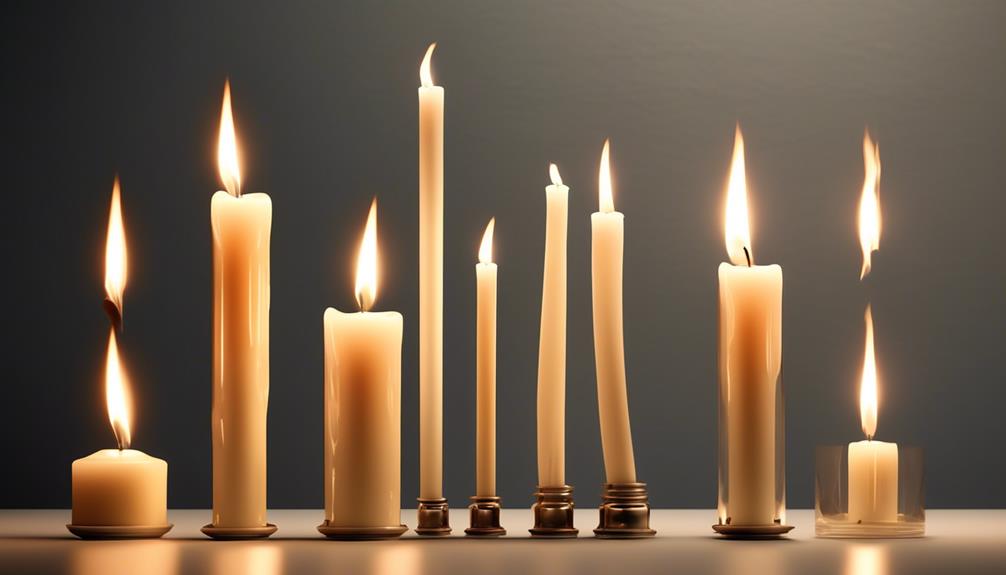
When it comes to candle size and heat output, we need to consider how the flame size influences the temperature it reaches and the burning time effects on the candle.
Understanding the relationship between these factors can help us grasp the variations in heat intensity produced by candles of different sizes.
Flame Size Influence
Exploring the relationship between candle size and heat output provides valuable insights into the influence of flame size on the temperature distribution within the flame. When considering flame size influence, factors such as the type of candle and fuel consumption play crucial roles in determining the heat output. Understanding these dynamics can aid in optimizing the burning process for desired results.
To delve deeper into this subject, we must acknowledge the significance of flame size on the overall temperature distribution within a candle flame. By grasping the impact of flame size influence, we can enhance our knowledge of candle burning mechanisms and improve our ability to control heat output effectively.
Burning Time Effects
Considering the influence of flame size on heat output, we now turn our attention to the effects of burning time on candle size and heat distribution.
The burning time effects are significant in determining the amount of heat produced by a candle. As a candle burns, the wax is consumed, leading to a decrease in its size. This reduction in candle size affects the surface area available for heat transfer, influencing the temperature of the flame and the hottest part of the candle.
Additionally, burning time impacts the heat distribution within the surrounding environment, affecting the ambient air temperature. Understanding how burning time affects candle size and heat output is crucial for controlling the heat generated by candles and optimizing their efficiency.
Measuring Flame Temperature Methods
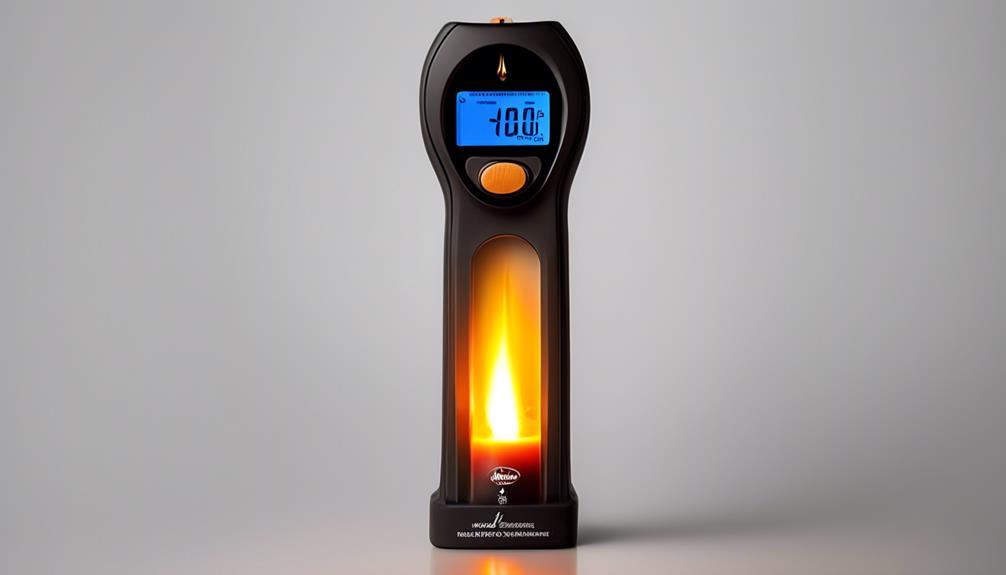
We will explore various methods for measuring flame temperature, including using thermocouples for direct temperature readings, employing pyrometers for non-contact measurements, and utilizing infrared technology with infrared thermometers.
These techniques provide accurate ways to assess the temperature of a flame, crucial for understanding combustion processes and fire safety measures.
Flame Temperature Measurement
Utilizing various methods such as thermocouples, infrared pyrometry, spectroscopy, colorimetry, and flame ionization thermometry enables accurate measurement of flame temperature.
When it comes to burning candles, understanding flame temperatures is crucial for safety and efficiency.
Here's why mastering flame temperature measurement methods matters:
- Safety: Accurate temperature measurement helps prevent overheating, reducing the risk of accidents.
- Efficiency: Knowing the flame temperature optimizes burning conditions, ensuring candles burn evenly and last longer.
- Quality: Precise temperature control results in consistent candle quality, from fragrance release to wax melting point.
Thermocouple Usage
Thermocouples, essential tools for measuring flame temperature, utilize two dissimilar metals to produce a voltage proportional to the temperature difference within candle flames. By placing the thermocouple junction in the burning candle's flame, an accurate temperature measurement can be obtained. The voltage output is then converted into temperature readings using specialized equipment. These devices offer real-time temperature data crucial for research, industrial processes, and candle manufacturing. Here is a table illustrating the advantages of thermocouples in measuring flame temperature:
| Measurement | Advantages | Disadvantages |
|---|---|---|
| Temperature Accuracy | High | Susceptible to thermal shock |
| Response Time | Fast | Calibration needed |
| Durability | Robust | Expensive initial setup |
Pyrometer Applications
Having explored thermocouple usage for measuring flame temperature, our focus now shifts to the diverse applications of pyrometers in analyzing and controlling flame temperatures using various innovative methods.
When it comes to candle flames, pyrometers play a crucial role in determining their temperature accurately. Here are three key methods used in pyrometer applications:
- Contact pyrometers utilize a thermocouple or thermopile to directly measure the temperature of candle flames by making physical contact with them.
- Non-contact pyrometers, like infrared pyrometers, measure the thermal radiation emitted by candle flames to determine their temperature without direct contact.
- Spectroscopic pyrometers analyze the spectrum of light emitted by candle flames to calculate their temperature based on the relationship between temperature and light wavelength.
These advanced techniques ensure precise temperature control for optimal performance and safety.
Candle Flame Vs. Wax Temperature
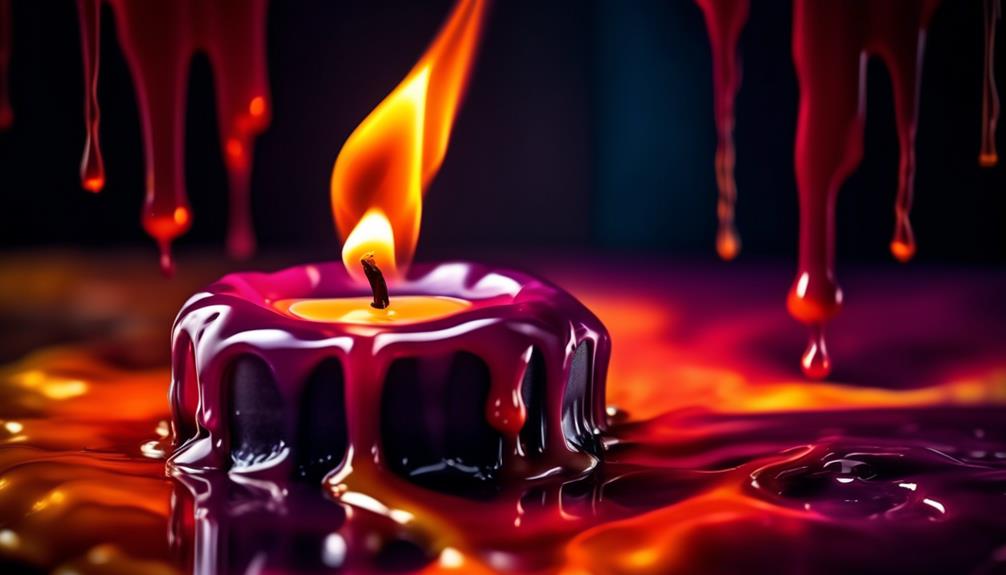
When considering the comparison between candle flame and wax temperature, it becomes evident that the average candle flame can range from 800 to 1400 degrees Fahrenheit. Understanding the temperature of the flame in relation to the wax it melts can provide valuable insights into the dynamics of a burning candle.
| Type of Wax | Melting Point Range (°F) |
|---|---|
| Paraffin Wax | 99 – 154 |
| Beeswax | 144 – 147 |
| Soy Wax | 130 – 150 |
The flame temperature of a candle is influenced by various factors such as the type of wax used, wick size, oxygen availability, and ambient conditions. The hottest part of the flame is the blue region near the base, while the outer red to orange part is cooler. Paraffin wax tends to melt at lower temperatures compared to beeswax and soy wax. By understanding the interplay between flame temperature and wax characteristics, one can appreciate the science behind the art of candle burning.
Environmental Temperature Effects
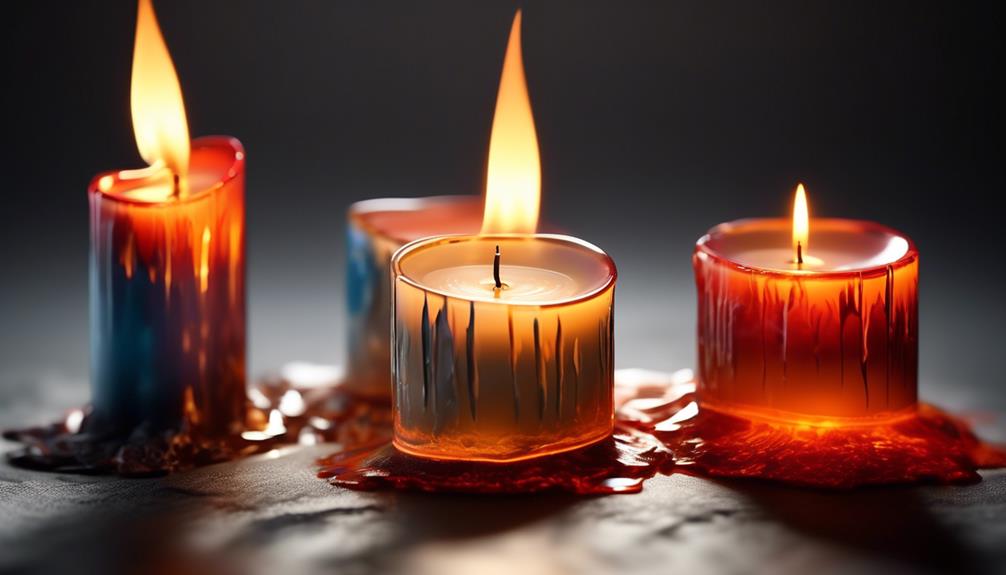
Considering the impact of environmental temperature on the dynamics of candle burning, we observe a crucial interplay between external conditions and the flame's behavior. The temperature of the surrounding environment significantly influences how a candle burns.
Here's how:
- Higher Temperatures: When the environmental temperature is high, the candle burns more efficiently. The increased heat helps vaporize the wax, allowing it to mix better with oxygen in the air, resulting in a steadier and brighter flame.
- Lower Temperatures: In colder environments, candles may burn less efficiently. The wax may not vaporize as effectively, leading to incomplete combustion and a dimmer flame. This can also cause the candle to produce more soot.
- Optimal Temperatures: A moderate environmental temperature provides the ideal conditions for candle burning. It ensures a balanced combustion process, producing a stable flame and maximizing the candle's lifespan.
Understanding how environmental temperature affects candle burning can help us optimize the conditions for a more efficient and aesthetically pleasing flame.
Safety Precautions for Candle Burns
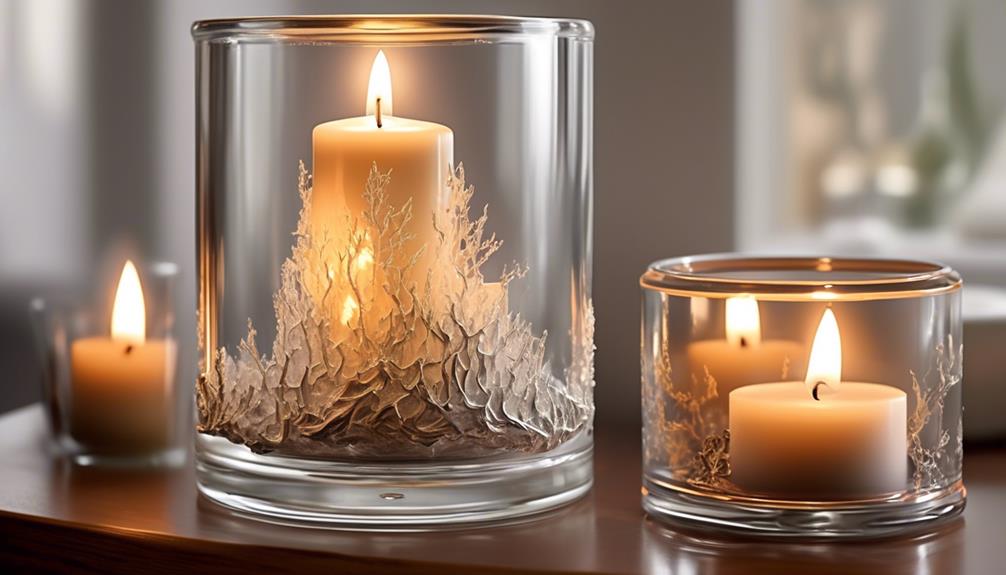
Implementing safety precautions for candle burns ensures a secure environment and minimizes the risk of accidents. It is essential to follow these guidelines to prevent potential hazards. Placing candles on heat-resistant surfaces like glass can prevent accidental fires or burns. Keeping candles away from drafts and flammable materials reduces the risk of tipping over or catching fire. Never leave a burning candle unattended as it can lead to fires or injuries. Using a candle snuffer to extinguish a candle instead of blowing it out can prevent hot wax splattering and potential burns. Keeping candles out of reach of children and pets can also prevent accidental contact and injuries. By adhering to these safety measures, one can enjoy the ambiance of candlelight without compromising safety.
| Safety Precaution | Description | Importance |
|---|---|---|
| Place candles on heat-resistant surfaces | Prevents accidental fires or burns | Critical |
| Keep candles away from drafts and flammable items | Reduces risk of tipping over or catching fire | Essential |
| Never leave a burning candle unattended | Prevents fires or injuries | Crucial |
| Use a candle snuffer to extinguish the flame | Avoids hot wax splattering and potential burns | Important |
| Keep candles out of reach of children and pets | Prevents accidental contact and injuries | Vital |
Container Jar Heat Limits
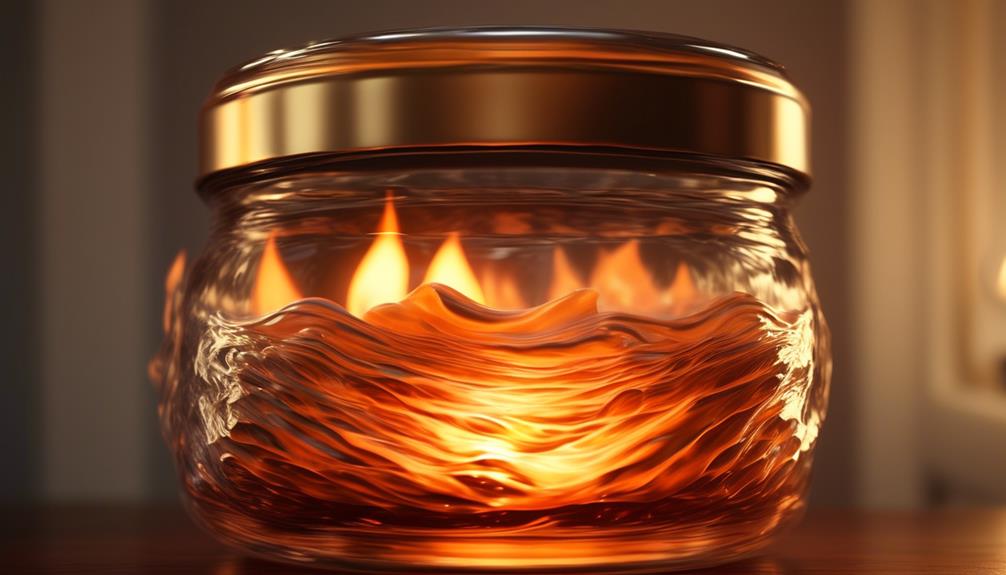
To ensure the safety of candle usage, understanding the heat limits of container jars is crucial due to the potential hazards posed by the high temperatures reached near the flame.
When it comes to candle jar heat limits, there are several key considerations to keep in mind:
- The heat generated by a candle can cause the glass jar to become hot to the touch, potentially leading to thermal stress that may cause the glass to crack.
- The temperature near the flame of a burning candle can reach incredibly high levels, between approximately 800 to 1,200 degrees Fahrenheit (427 to 649 degrees Celsius), which can easily exceed the heat resistance of standard glass jars.
- Candle manufacturers often recommend using containers specifically designed to withstand the high temperatures of a burning candle to prevent the glass from cracking or the melted wax from leaking out.
Understanding these factors can help users make informed decisions about the types of candle jars they use, ensuring a safer and more enjoyable candle-burning experience.
Candle Heat Distribution
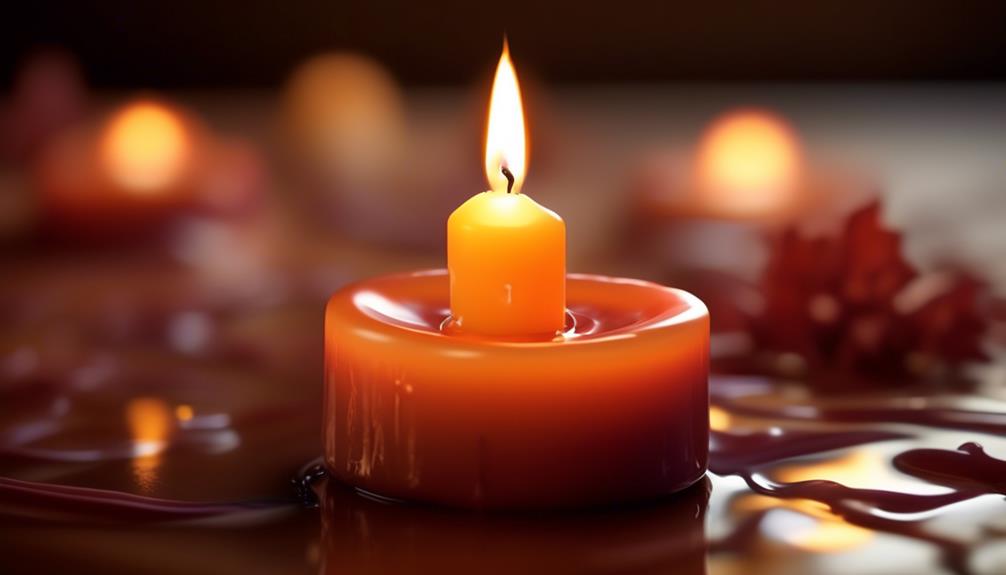
When studying candle heat distribution, we observe the varying temperatures across a flame and how heat spreads through the wax.
By analyzing flame temperature distribution, we can understand how different parts of the candle burn at different intensities.
This insight into wax melting heat spread is crucial for comprehending the overall burning process.
Flame Temperature Distribution
In understanding the distribution of flame temperatures in a burning candle, we delve into the intricate heat patterns generated by the flickering flame. The flame temperature distribution is a crucial aspect to comprehend when examining the dynamics of a candle's combustion process. Here are three key points to consider:
- The flame temperature distribution in a candle isn't uniform, with the highest temperatures concentrated at the base of the flame.
- During combustion, paraffin wax in the candle fuel undergoes a chemical reaction with oxygen, producing carbon dioxide and water vapor.
- Understanding the flame temperature distribution can provide insights into the efficiency of the candle's burning process and the amount of heat and light it emits.
Wax Melting Heat Spread
Considering the intricacies of flame temperature distribution in a burning candle, we now focus on the wax melting heat spread, which plays a crucial role in the overall candle heat distribution.
In candle making, the wax melting heat spread refers to how efficiently the heat from the flame is transferred to melt the surrounding wax. This process is vital as it influences the temperature gradient within the candle, affecting how evenly the wax is consumed and the overall burn time.
Candle Flame Applications

Exploring various practical uses of candle flames reveals their diverse applications in both traditional and modern contexts. Candle flames, with their unique temperature properties and characteristics, have been utilized in numerous ways throughout history. Here are three compelling applications that showcase the versatility of candle flames:
- Temperature Regulation: Candle flames have been employed in small-scale heating applications, such as warming food or beverages during power outages or outdoor activities. The ability of candle flames to generate localized heat at specific temperatures makes them a convenient and reliable source of warmth in various settings.
- Aesthetic Lighting: Beyond their practical uses, candle flames are often used for decorative purposes, creating a warm and inviting ambiance in homes, restaurants, and events. The flickering flame adds a sense of coziness and intimacy to any space, enhancing the overall atmosphere.
- Rituals and Ceremonies: In religious and cultural practices, candle flames hold symbolic significance, representing hope, spirituality, and remembrance. Lighting candles during ceremonies or rituals is a common tradition that transcends various belief systems, underscoring the enduring cultural relevance of candle flames.
Room Heating Potential
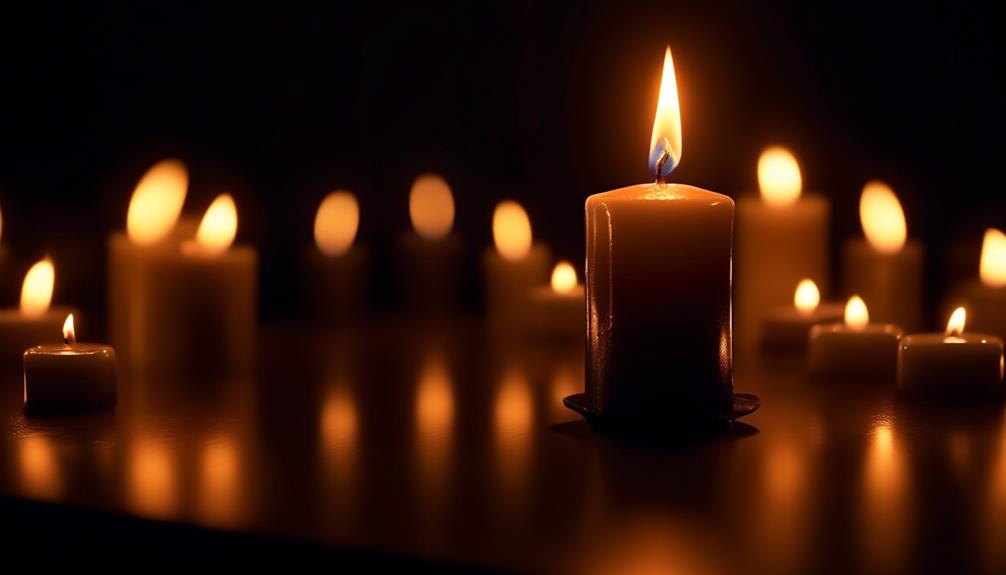
Our exploration of candle flame applications leads us to the intriguing realm of room heating potential, where candles can serve as a localized source of warmth in small spaces. Candles have the ability to generate significant heat, with the outer core of the flame reaching temperatures as high as 1670K (approximately 2396 degrees Fahrenheit). The heat produced by a burning candle is radiated in various directions, making it suitable for heating enclosed areas. Factors such as the size and type of candle, as well as the duration of burning, can influence the amount of heat emitted. It is essential to follow safety measures when using candles for room heating, including placing them on heat-resistant surfaces and keeping them away from flammable materials. While candles can contribute to raising the temperature in a room, they should not be solely relied upon for heating larger spaces.
| Temperature | Heat | Burning |
|---|---|---|
| 1670K | Significant | Produces heat |
Frequently Asked Questions
What Temperature Is a Candle Burn?
We know that a candle's burn temperature can vary based on factors like fuel type, wick material, and environmental conditions. The hottest part of the flame is the blue area near the base, while the outer region is cooler.
Safety measures, such as using heat-resistant surfaces and avoiding drafts, are crucial. Always stay vigilant and attentive when a candle is burning to prevent accidents.
Candle safety is paramount for a worry-free ambiance.
How Hot Does Candle Wax Get?
When discussing how hot candle wax gets, it's essential to consider various factors. The temperature can reach different levels based on the type of wax and burning conditions. Factors like the wick, environment, and candle design can impact the wax temperature significantly.
Understanding these components is crucial for mastering candle safety and efficiency. Being mindful of these elements ensures proper handling and enjoyment of candles.
How Much Heat Does a Candle Give Out?
When considering how much heat a candle gives out, it's essential to factor in various elements such as the type of fuel, wick size, oxygen supply, and ambient temperature.
The average temperature of a candle flame typically falls within the range of 800 to 1400 degrees Fahrenheit.
Understanding these factors can help us comprehend the heat output of a candle and the impact it has on its surroundings.
How Hot Is the Top of a Candle Flame?
At the top of a candle flame, the temperature can reach around 1670K, making it the hottest part of the flame. This outer core radiates a light blue color and signifies the highest temperature within the flame.
As we move towards the center of the flame, the temperature gradually decreases, with the red portion having a temperature of about 1070K.
Understanding these temperature variations can enhance our knowledge of candle flames.
Conclusion
In conclusion, the temperature of a candle flame can reach up to 1400 degrees Fahrenheit, making it a powerful source of heat.
However, it's crucial to remember that this seemingly small source of light can also pose a significant fire hazard if not handled with care.
By understanding the factors that influence the temperature of a candle flame, we can enjoy the warmth and ambiance it provides while ensuring our safety.
Stay informed, stay safe.
